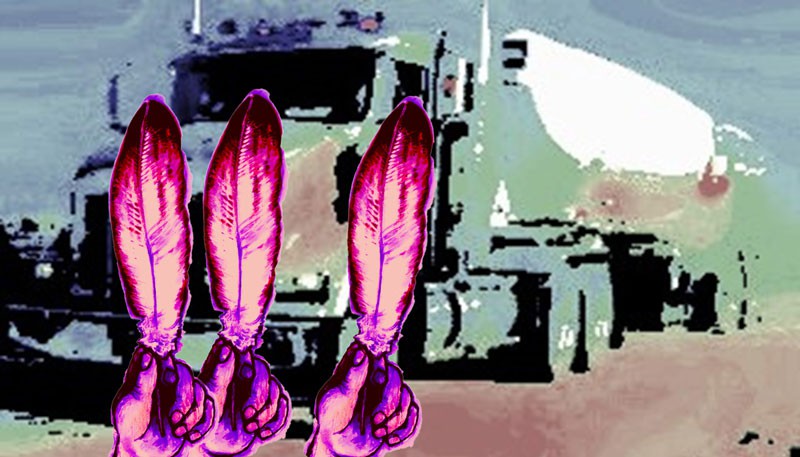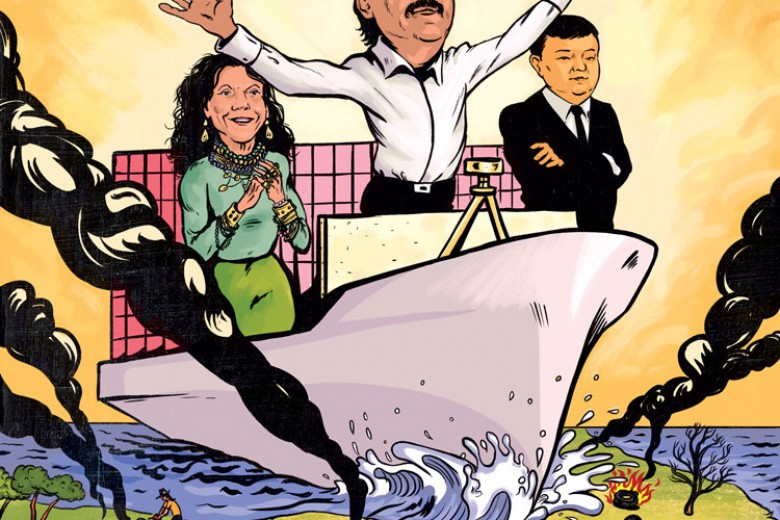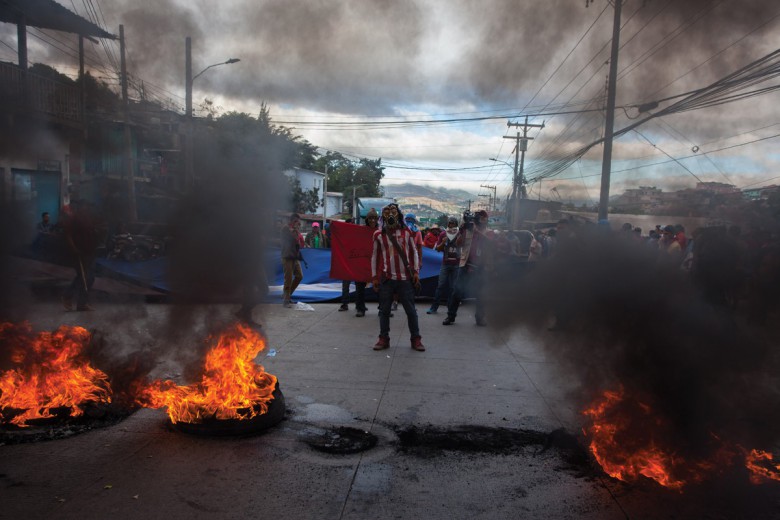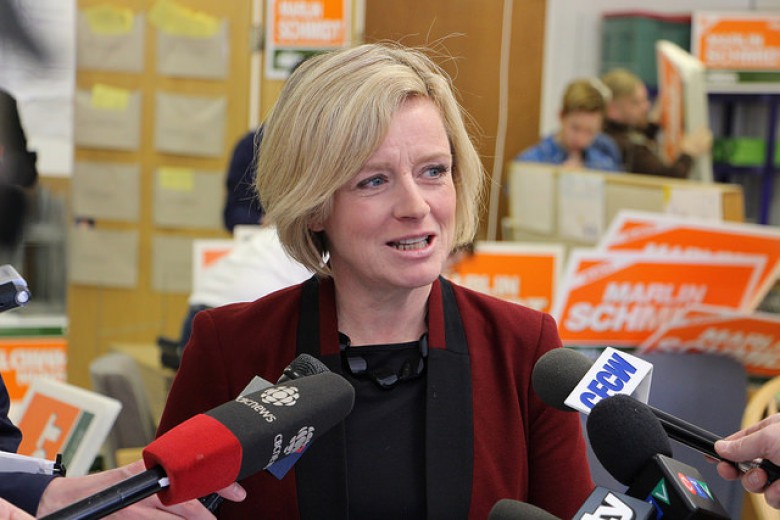
My name is Elle-Máijá Apiniskim Tailfeathers, and I am both Blackfoot from Kainai, also known as the Blood reserve in Alberta, and Sámi from Arctic Norway. I do not claim to speak on behalf of my people, but rather as a member of a community that has the health of our people and land as our top priority.
On September 9, 2011, Blood Tribe Police arrested me along with two other unarmed women from the Blood Tribe during a peaceful blockade on the Blood reserve. We were kept in a holding cell overnight and charged with intimidation under Section 423 (1)(g) of the Criminal Code. However, we have yet to be convicted of anything as our court case is ongoing.
Our actions were not done in haste. In fact, this was only the most recent action taken after nearly a year’s worth of attempts to prevent new oil and gas development from happening on our land.
The Blood reserve is a part of the Blackfoot Confederacy. Spanning approximately 884 square kilometres in southern Alberta, it is the largest reserve in Canada. The Blood Tribe comprises over 10,000 members, half of whom live on reserve.
In the fall of 2010, the Blood Tribe chief and council, along with their company, Kainai Resources Inc., signed one of the largest oil and gas deals in First Nations’ history, netting the Blood Tribe over $50 million. Prior to negotiating and signing the deal with Murphy Oil and Bowood Energy, the Blood Tribe chief and council did not fulfill their obligation to obtain the free, prior, and informed consent of members of the Blood Tribe. There were no referendums, no letters, and no phone calls to members that would constitute legitimate forms of open and transparent consultation.
The deal itself involves a five-year lease, during which time oil and gas companies have access to over 50 per cent of Blood Tribe land, where they intend to build over 200 oil and gas wells.
The extraction method being used is known as hydraulic fracturing, other-wise known as fracking. Fracking involves pumping between one and eight million gallons of water, proprietary chemicals, and sand under high pressure into a well. This causes the shale or coal bed to fracture, releasing the desired natural gas from the well. Between 80 and 300 tons of chemicals may be used each time a well is fracked, which can happen up to 18 times during its lifetime.
The proprietary nature of fracking chemicals keeps them largely hidden from the public; however, it is known that chemicals such as benzene, lead, boric acid, and toluene are often used in the process. It is estimated that only 30 to 50 per cent of fracking fluids are recovered after the process, leaving toxic waste to seep into the groundwater and soil surrounding the well. Given the incredibly toxic nature of this form of extraction, fracking has been banned in numerous countries and states around the world. Unfortunately, it remains unregulated in Canada.
In early December 2011, the movement against fracking had a minor win when the U.S. Environmental Protection Agency (EPA) stated for the first time that it found chemicals used to extract natural gas through fracking in a drinking water aquifer in west-central Wyoming. In other words, EPA experts and scientists have made a clear link between water contamination and fracking.
The first question asked when the issue of fracking on Kainai territory is presented to new ears is often, “How could this happen?” It is a difficult question to answer, but there are four major players: the gas and oil companies; government, both provincial and federal; the Blood Tribe chief and council; and the Blood Tribe member population. The issue also fits into a larger narrative of power, oppression, and colonialism. Although our prime minister professes otherwise, Canada was founded on the systemic colonial exploitation of Indigenous peoples and our land. Our story is nothing new; history is simply repeating itself. Only this time around, it is not a case of Red versus White.
Indigenous peoples are in a unique position as a population living on the margins of Canadian society, faced with a long list of social issues due to a violent history of colonialism. Because of our resource-rich lands and our unique relationship with the Crown, we find ourselves targets for resource development companies. This is manifested in the rhetoric of “economic development,” which is the ideology that purports to solve today’s “Indian Problem” by extracting resources from our land and, in theory, generating employment and sustainable futures for Indigenous peoples. However, economic development rarely plays out this way in real life. Instead, resource development companies bring in their own trained staff for the short-term period of development contracts, typically leaving Indigenous communities with the task of cleaning up the mess.
Indigenous peoples are not the same as other Canadians in the eyes of the law – nor should we be. However, as long as the issue of Aboriginal rights and title to land and resources remains unresolved, resource development companies can essentially do as they wish with Indigenous lands and resources without being held accountable to provincial and federal governments. These governments in turn benefit from the exploitation of resources on Indigenous land.
Perhaps the most contentious player in this game is the Blood Tribe chief and council. The band council system is itself deeply flawed and in no way represents traditional Indigenous self-governance. In fact, many would argue that band councils are inherently designed to fail. After all, how could the federal government continue to benefit from the exploitation of Indigenous lands and resources if they had to negotiate on an even playing field with First Nations? This might mean that they would have to actually honour and uphold the original nation-to-nation relationship established in our historic treaties.
This system can lead to a plethora of problems such as corruption and nepotism, as in the case of the Blood Tribe, and to other crises such as what we are currently seeing in Attawapiskat. Due to a severe lack of housing, Chief Theresa Spence declared a state of emergency in her remote northern community in October 2011. Rather than take into account the human lives were, and are, at stake, Prime Minister Stephen Harper and Aboriginal Affairs Minister John Duncan sent in an accountant to get to the root of the purported “mismanagement” of approximately $90 million.
What both Harper and Duncan failed to mention was that this $90 million was intended to cover every expense for the entire community, ranging from health care to education, over a five-year period, which was not enough to meet the community’s needs. Furthermore, these funds were not simply thrown at the Attawapiskat chief and council; instead, a federal accountant had to approve them at some point along the way.
Attawapiskat is also no stranger to the toxic effects of resource development on its land and water. In 2002, Attawapiskat signed a feasibility partnering agreement with De Beers mining company. Seven years later, Chief Spence publicly voiced serious concerns about the probability that the De Beers Victor open-pit diamond mine was polluting the Attawapiskat River. Residents began to experience sewage backups in their homes shortly after De Beers decided to dispose of their sewage sludge in the community’s lift station, contributing, say residents, to the current housing crisis.
In the case of the Blood Tribe chief and council, Aboriginal Affairs and the federal government have ignored the chief and council’s blatant violation of our member population’s basic rights. Ultimately, this perpetuates the vicious cycle of nepotism and corruption within the band council.
This corruption is by no means some sort of inherent trait of Indigenous peoples; rather, it is a symptom of colonialism. It is no secret that Indigenous peoples are faced with the daily reality of lateral violence; however, it is critical to recognize that the root of this violence stems from deeply internalized oppression. Essentially, we have been hated for so damn long that some of us have succumbed to turning that very same hate on our own people. In truth, the Blood Tribe chief and council’s choice to blatantly ignore the health and well-being of our people and our land was an act of violence.
Finally, we have the member population of the Blood Tribe. As I mentioned, the large majority of us were left in the dark about the negotiations between chief and council and the oil companies until after the deal was signed. In fact, many of us found out about it through the media. Following the release of this news, chief and council, along with reps from the oil companies, held information sessions telling tribal members what was going to happen to our land, regardless of what we had to say about it. In the information brochures handed out at these community meetings, Murphy Oil proudly claimed to have done assessments with tribal “elders” over the cultural and archaeological significance of desired well sites. It seems as though Murphy simply found elderly members of the Blood Tribe to take part in these consultations. However, it takes more than old age to be considered a respected elder within our community. To add insult to injury, Murphy Oil also proudly claims to perform “ceremonial offerings” to the land before and after a well is built.
Like many, I would like to believe that chief and council had our best interests in mind when they signed the deal. I am sure that they hoped this deal would somehow remedy the astonishingly high rate of unemployment on reserve. However, their actions speak otherwise. Over the last year, a number of distribution cheques were doled out, supposedly from revenue generated by this deal. But, just as before, chief and council failed to consult with the member population as to where the funds from the deal should be allocated.
Interestingly enough, the first distribution cheques, approximately $800, were handed out 10 days before Christmas 2010. I don’t know too many people who are broke and have mouths to feed who would turn down $800 before Christmas. This has put many of our members in a difficult situation because they feel they no longer have the right to speak out now that they have accepted the cheques.
Most of the jobs that do exist on reserve are through the tribe chief and council. Many of those employed by the tribe who spoke out received threats that they would lose their jobs, and some actually did. That being said, it is not as though our community is simply keeping silent and doing nothing. Instead, there has been a small and growing resistance consisting of both non-members and members of the Blood Tribe who have taken various forms of non-violent direct action, including writing letters to every level of government, contacting the oil companies and the Alberta Energy Resources Conservation Board, voicing our concerns to chief and council, and raising awareness both on and off reserve.
Despite our efforts, fracking went ahead on Blood land. Ultimately, this is what led a small group of peaceful protesters to gather and establish a blockade on September 9, 2011. Since then, Kainai residents have begun to witness the effects of fracking first-hand. So far, two earthquakes have been recorded on Blood land, and the distinct fume of sour gas is seemingly always present near the well sites. On a particularly windy day in early December 2011, a number of students at the Kainai middle school became physically ill, experiencing vomiting and dizziness after exposure to the sour gas fumes from a nearby well site. This is all deeply troubling, and the situation will likely only get worse as long as fracking continues on Blood land.
Where do we go from here? I do not have the means to prescribe a solution, but here are some thoughts. As the Assembly of First Nations Grand Chief Shawn Atleo has stated, “We must move beyond the Indian Act, and we must affirm our Crown-First Nation relationship.” We must also continue to urge every level of government to make serious reforms in climate action and energy policies. Apathy is our largest adversary, so if we wish to see change, it is critical that we recognize our own complicity within the global dependency on gas and oil. Furthermore, we must also recognize that resource development on Indigenous land is not just an Indigenous issue; it is a global issue.
An earlier version of this article was first published in Redwire Magazine.
For more information on fracking in Kainai territory, visit protectbloodland.ca and the Kainai Lethbridge Earthwatch at KLEW.





_780_520_90_s_c1_c_c.jpg)
